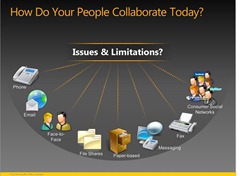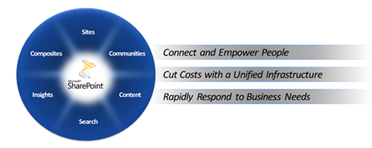Improving Organization Collaboration with SharePoint
 Organizations know the value of their information, and that using it effectively can be an advantage. But as organizations grow, understanding where that information is stored or which the latest version is becomes more complex. Finding a solution to this problem then becomes the IT Departments challenge, and in some cases they are seen as the cause of the issue in the first place. As IT Professionals, when addressing this issue the pitfall to avoid is to think that this is no more than a storage problem.
Organizations know the value of their information, and that using it effectively can be an advantage. But as organizations grow, understanding where that information is stored or which the latest version is becomes more complex. Finding a solution to this problem then becomes the IT Departments challenge, and in some cases they are seen as the cause of the issue in the first place. As IT Professionals, when addressing this issue the pitfall to avoid is to think that this is no more than a storage problem.
In fact, what is actually required is a way of:
- Extracting information from silos and making it more widely available
- Achieving this in a way that remains relevant to each department or team of employees
- Enabling people to share information widely, yet in a secure and controlled fashion
- …and letting them search entire repositories quickly and efficiently
 In this 2 part post We’ll cover how deploying SharePoint into an organization provides the capabilities that address the requirements above.
In this 2 part post We’ll cover how deploying SharePoint into an organization provides the capabilities that address the requirements above.
SharePoint comes in two versions
- SharePoint Foundation 2010 (Formally Windows SharePoint Services)
- SharePoint Server 2010
For complete awareness, there is also another product that shares the SharePoint name, SharePoint Workspace 2010 (Formally Microsoft Office Groove 2007).
Both of these products share platform and management capabilities, but the first big difference is that SharePoint Foundation 2010 can download for free.
When we talk about shared capabilities within these products that enable collaboration, primarily we are looking at:
- Documents library
- Calendar
- Team Discussion list
- Tasks list
- Links list
When we compare this list of capabilities to the requirements above we can start to connect them.
Extracting information from silos and making it more widely available.
Within a SharePoint site, teams can create libraries to store the information that once lived on their local computers or in emails. These libraries can hold documents of many descriptions, calendar information, custom lists and tasks, and even newsgroup style forums. All provide a means to move the information locked up in various silos into mainstream view. Once in these libraries, the search service in SharePoint can help people find this information quickly.
Achieving this in a way that remains relevant to each department or team of employees.
Creating one site for everyone has both advantages and disadvantages. The more your organization grows, the more congested a single site could become. While the storage engine behind SharePoint, which is SQL Server, is fully capable of handling the quantity of information being stored, people will be put off if the sites are not easy to use or if they have take much time to wade through multiple search results. SharePoint provides a solution to this through the ability to create multiple sites. Now each team can create a view of their information based on how they work best, but still share this information and make it available to other teams.
Enabling people to share information widely, yet in a secure and controlled fashion.
One possible reason information is locked away is that teams may not want to distribute it broadly. Documents may be in early draft form, or subject to change. To help prevent this scenario teams can allow access to sites and libraries using the security model.
SharePoint makes collaboration very easy, yet this ease of use is also something to be wary of, so planning how your sites and site collections will be created is very important.
In the next post we’ll cover more details about the capabilities within SharePoint.